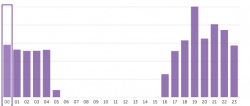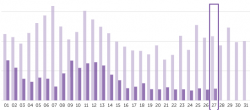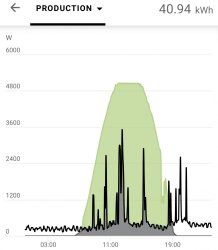You are using an out of date browser. It may not display this or other websites correctly.
You should upgrade or use an alternative browser.
You should upgrade or use an alternative browser.
Solar Panel, Power & Battery Discussion
- Thread starter clazman
- Start date
Hvr
Enthusiast
- Joined
- Jun 27, 2007
- Posts
- 10,894
- Qantas
- LT Gold
Depending on your inverter features, you should also be able to see how much solar was self-consumed..
Ie. Generally reducing your shoulder (7am-2pm and 8-10pm) and peak (2-8pm) usage.
Here in Victoria I use this site Site Login
to see actual use, export with fugues provided on the half hour. Also gives weekly, monthly and season stats.
You have to register with your NMI and then it's good to go.
Can't see why they wouldn't have the same sort of information available in other states, and/or with other power generators. As noted above I use GloBird but PowerCorp is the original generator.
- Joined
- Oct 13, 2013
- Posts
- 17,095
My provider Energy Australia (NSW) provides via their website/app, daily, weekly, monthly annual use
It does not provide actual "direct use" from panels which I get from the Inverter app.
In order to compare apples with apples, you need to add the consumption from direct use to the consumption imported from the grid to know your total
electricity consumption for any period.
Any amount in savings" only comes the $$ saved due to consumption diretly supplied by panels plus any FiT.
As you can see the electricity imported from the Grid in October is currently running about 30% compared to last year. However this does not mean the solar panels
have saved me 70%. In actual fact, my imported electricity has reduced by 50% compared to last year but not from solar panels . The solar panels have then reduced it by another 20%.(using data from inverter app which gives the amount consumed directly from panels ) So the net import from Grid is only 30% of last year.
I should be able to export about 8-9000kWh during Summer
Daily import from the Grid

Daily import from the Grid - monthly view with same period last year in light purple

It does not provide actual "direct use" from panels which I get from the Inverter app.
In order to compare apples with apples, you need to add the consumption from direct use to the consumption imported from the grid to know your total
electricity consumption for any period.
Any amount in savings" only comes the $$ saved due to consumption diretly supplied by panels plus any FiT.
As you can see the electricity imported from the Grid in October is currently running about 30% compared to last year. However this does not mean the solar panels
have saved me 70%. In actual fact, my imported electricity has reduced by 50% compared to last year but not from solar panels . The solar panels have then reduced it by another 20%.(using data from inverter app which gives the amount consumed directly from panels ) So the net import from Grid is only 30% of last year.
I should be able to export about 8-9000kWh during Summer
Daily import from the Grid

Daily import from the Grid - monthly view with same period last year in light purple

Flying mermaid
Senior Member
- Joined
- May 20, 2011
- Posts
- 6,125
- Qantas
- Platinum
Because of the lack of rain we are now generating close to 80kwh per day - higher than normal for October. Putting about 55kwh per day into the grid and self consumption for the rest.
moa999
Enthusiast
- Joined
- Jun 23, 2003
- Posts
- 13,552
we are now generating close to 80kwh per day -
That's a massive system I take it. How many panels?
@Quickstatus
Interesting that you are having to use some grid power from as early as 4pm. Do you get afternoon shade?
- Joined
- Oct 13, 2013
- Posts
- 17,095
At the other place, I installed a 5kW inverter but with 3.35kW on the N aspect plus 2.65kW on the W aspect:
So there are 6kW panels into a 5kW inverter.
Here is a sunny October day production. Note the plateau (clipping) at the top of the peak. Thats the 5kWh limit. By overprovisioning, I get the inverter to operate at its 5kWh rating for a longer period in the year. Overall relative cost per kWh is therefore lower.
I am assured that it is safe - the production is adjusted so that the 5kWh rating is not exceeded hence the plateau. Heat and overvoltage is the biggest killer. Despite the over provisioning the actual inverter voltage is less than the limit of 1000V
Currently at my place with 20kW (67 panels) installed NE aspect, the panels are producing around 140kWh per day in October. Another 8kW will go in later. (25kW inverter). The curve below is for the 5kW inverter place.

So there are 6kW panels into a 5kW inverter.
Here is a sunny October day production. Note the plateau (clipping) at the top of the peak. Thats the 5kWh limit. By overprovisioning, I get the inverter to operate at its 5kWh rating for a longer period in the year. Overall relative cost per kWh is therefore lower.
I am assured that it is safe - the production is adjusted so that the 5kWh rating is not exceeded hence the plateau. Heat and overvoltage is the biggest killer. Despite the over provisioning the actual inverter voltage is less than the limit of 1000V
Currently at my place with 20kW (67 panels) installed NE aspect, the panels are producing around 140kWh per day in October. Another 8kW will go in later. (25kW inverter). The curve below is for the 5kW inverter place.

Last edited:
- Joined
- Oct 13, 2013
- Posts
- 17,095
My problem is that my panels are NE facing. Which means it peaks at 1100am.
I have a NW roof but it is shaded from 4pm in summer and 12pm in winter - so no panels ate on that part of the roof
I have 8kW yet to be installed but it will be a ground mounted NW aspect in a sunny spot
I have a NW roof but it is shaded from 4pm in summer and 12pm in winter - so no panels ate on that part of the roof
I have 8kW yet to be installed but it will be a ground mounted NW aspect in a sunny spot
Flying mermaid
Senior Member
- Joined
- May 20, 2011
- Posts
- 6,125
- Qantas
- Platinum
40 panels - 20 facing east and 20 west. In theory a 13.2 kw system, but in practice because of the east west orientation we never go much over 10. Because we are home during the day it works well for us - at the moment we are covering all our consumption between 6am and 6pm.That's a massive system I take it. How many panels?
For our family it has been solar, LED lighting and Toyota Camry hybrids at work. The cars are running 70 miles to a gallon of 98 fuel or 4.5 litres to 100 kms.
With solar anyone who has a work office where you operate sunlight hours gives a pretty good saving where the payback should be in the 3 to 5 years range..
This year at work our overall electricity account should be closer to zero than any previous year. Our peak was $152,000 about 4 years ago.
We put solar and LED lighting on tenants buildings too so it has been good for keeping our commercial tenants happy.
Two more hybrid Camrys are due to get delivered this week so they still have quite a wait from ordering to delivery of about 4 months.
With solar anyone who has a work office where you operate sunlight hours gives a pretty good saving where the payback should be in the 3 to 5 years range..
This year at work our overall electricity account should be closer to zero than any previous year. Our peak was $152,000 about 4 years ago.
We put solar and LED lighting on tenants buildings too so it has been good for keeping our commercial tenants happy.
Two more hybrid Camrys are due to get delivered this week so they still have quite a wait from ordering to delivery of about 4 months.
- Joined
- Oct 13, 2013
- Posts
- 17,095
The 6kW place i referred to above is a residential tenanted property. It appears that their annualised electricity bill will be very close to zero - They keep the FiT even though the asset cost is on me. the rent is slightly higher but happy tenants
rogerkambah
In memoriam
- Joined
- Aug 3, 2012
- Posts
- 1,056
That's interesting.40 panels - 20 facing east and 20 west. In theory a 13.2 kw system, but in practice because of the east west orientation we never go much over 10. Because we are home during the day it works well for us - at the moment we are covering all our consumption between 6am and 6pm.
I have just had a quote to do a 40 panel 13.2kv system with 30 panels west and 10 east for $11,450.
Just wondering if this is a reasonable deal or not.
- Joined
- Oct 13, 2013
- Posts
- 17,095
Anything around $1 per W is a good price.
Mine came in at $1.1 per Watt for the primary residence but thats because I upsized the 3 phase inverter by 25% to accomodate future panels as those panels likely be ground mount.
At the 6kW panel/ 5kW inverter place, the production for the month of October has hit 1000kWh. When it was a 5kW panel system the installer predicted it would hit 1000kWh production in January.. Likely the production will plateau a bit from now due to the inverter hitting its ratings but it will give 5kWh for more hours in the day than if I stayed with only 5kW panels.
Mine came in at $1.1 per Watt for the primary residence but thats because I upsized the 3 phase inverter by 25% to accomodate future panels as those panels likely be ground mount.
At the 6kW panel/ 5kW inverter place, the production for the month of October has hit 1000kWh. When it was a 5kW panel system the installer predicted it would hit 1000kWh production in January.. Likely the production will plateau a bit from now due to the inverter hitting its ratings but it will give 5kWh for more hours in the day than if I stayed with only 5kW panels.
Last edited:
Read our AFF credit card guides and start earning more points now.
AFF Supporters can remove this and all advertisements
Flying mermaid
Senior Member
- Joined
- May 20, 2011
- Posts
- 6,125
- Qantas
- Platinum
Sounds very good - ours was way more than that, although we went at the top end for panels and inverters. Do your homework on the installer though. When ACTEW came round to check it, the technician said there were some very dodgy installers around. There were only two he felt were good. One was Solarhub (which we used) and I can’t remember the other.That's interesting.
I have just had a quote to do a 40 panel 13.2kv system with 30 panels west and 10 east for $11,450.
Just wondering if this is a reasonable deal or not.
rogerkambah
In memoriam
- Joined
- Aug 3, 2012
- Posts
- 1,056
Mine is 3 phase as well, but in the quote the inverter is only 10kv.Anything around $1 per W is a good price.
Mine came in at $1.1 per Watt but thats because I upsized the 3 phase inverter by 25% to accomodate future panels as those panels likely be ground mount.
- Joined
- Oct 13, 2013
- Posts
- 17,095
Yes thats because your panel placement is east west. So likely the "real" production would be around 10kW. If you are able you can actually push the panel count up a bit more. One way is to check production during the summer months and if there is spare inverter capacity, and you got the $$ put in a few more. No use having an inverter with spare capacity. Your 10kW inverter rating is a continuous rating (providing it is in a well ventilated spot) within certain ambient temperature limits.Mine is 3 phase as well, but in the quote the inverter is only 10kv.
My 6kW place has 10 panels N and 8 panels W. Theoretically I am 20% overprovisioned on the nameplate basis but the W panels will produce a bit less than the N panels so I am approx 10% over.
Note that in summer, relative panel output is negatively affected by the heat. so it is quite possible that January production is slightly lower than predicted.
Last edited:
rogerkambah
In memoriam
- Joined
- Aug 3, 2012
- Posts
- 1,056
You probably have a high FIT as you installed a while ago. Current FIT is only 15c.Sounds very good - ours was way more than that, although we went at the top end for panels and inverters. Do your homework on the installer though. When ACTEW came round to check it, the technician said there were some very dodgy installers around. There were only two he felt were good. One was Solarhub (which we used) and I can’t remember the other.
This quote is from an installer approved by Finn Peacock (solarquotes.com.au) who has a lot of iteresting info on this website.
- Joined
- Oct 13, 2013
- Posts
- 17,095
Lower than yours. Only 12.5C Both systems installed in July19.You probably have a high FIT as you installed a while ago. Current FIT is only 15c.
This quote is from an installer approved by Finn Peacock (solarquotes.com.au) who has a lot of iteresting info on this website.
I suspect the FiT will go lower as time goes on, and we may hit a situation like some places in Darwin where the electricity grid will no longer accept further grid export. So get in now and pay off that solar array ASAP.
The other aspect of a FiT is to compare the Fit with the cost of your electricity at night (after discounts). I am on a Time of use tariff, so the off peak period tariff is 0.3C /kWh less than the FiT. Therefore, there is no financial point to shift the night time electric loads to the sunshine hours. Ill pay the 12.2c for each kWh I use at night, but get 12.5c for each kWh exported. Small change I know, but significant in that I dont need to change the way I use night time electricity.
Last edited:
Flying mermaid
Senior Member
- Joined
- May 20, 2011
- Posts
- 6,125
- Qantas
- Platinum
No we missed out on the really high ones - I have a friend who is getting over 40c. We have a FiT of 12.5. We could have got 20c, but because we knew we would still draw a lot of power from the grid in winter, we went with a 30% discount on gas and 25% on electric, rather than a high Fit and lower discounts. It works for us as 3 months of the year we consume everything we produce and put nothing into the grid. The other 9 months what we feed in more than covers what we draw out.You probably have a high FIT as you installed a while ago. Current FIT is only 15c.
This quote is from an installer approved by Finn Peacock (solarquotes.com.au) who has a lot of iteresting info on this website.
I think everyone has a different balance.
- Joined
- Oct 13, 2013
- Posts
- 17,095
I had a 20C Fit offer but it comes with a higher general tariff sting and would leave me worse off.
- Joined
- Oct 13, 2013
- Posts
- 17,095
The next thing I am going to do is to install a more powerful roof ventilation fan. As I already have solar I only need to install an electric fan. Not putting in whirlybirds - they are just a fancy passive chimney. That could reduce the heatload over the ceiling of the house (even though the ceiling is insulated)
Become an AFF member!
Join Australian Frequent Flyer (AFF) for free and unlock insider tips, exclusive deals, and global meetups with 65,000+ frequent flyers.AFF members can also access our Frequent Flyer Training courses, and upgrade to Fast-track your way to expert traveller status and unlock even more exclusive discounts!

AFF forum abbreviations
Wondering about Y, J or any of the other abbreviations used on our forum?Check out our guide to common AFF acronyms & abbreviations.
Currently Active Users
Total: 2,793 (members: 12, guests: 2,781)













